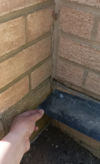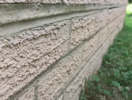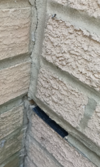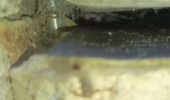Hi, after some advice on how to deal with an issue where it seems that the lower part of the dwarfwall on my conservary has sunk and separated at the dpc leaving a very large gap on both external an internal walls. The air gap is about 1.5cm at the largest tapers down for about 7ft of the length of the 10ft wall on both external and internal walls. This largest air gap is where the conservatory meets the house wall and tapers as you move away from the house wall. I guess the wall bracket is supporting a lot at the moment as the air gap is on both internal + external conservatory walls. Maybe relevant info is that there is a cavity of 5cm between internal and external conservatory walls which are both brick.
The conservatory is quite old, way more than 10years, and I'm pretty sure that this is something that's happened in the past quite some time ago and the base is no longer moving.
So far I have started working on the external wall only by cleaning both dpc sides, yes really, along with brick surface above/below as far as I can get. I have also used a small amount of silicone beneath the dpc to hold it in place as it seems mortar was only used above the dpc.
I have partially filled the gap with a 4:1 mortar to an approx depth of 5cm but leaving the end close to the wall open at the moment before I fill it with mortar after deciding best approach.
I have attached some images giving an indication of before and current situation.
So, is 5cm of mortar depth enough given that the bricks are 10cm in width? my concern, after supporting the wall, is for damp/moisture.
I intend to chase out the vertical mortar when the conservatory joins the house wall and replace with fresh mortar, but would it be a good idea to pump some expanding foam in there to reduce moisture/damp transmission? Would I need to be avoid bridging the internal/external wall cavity?
Also, I'm thinking that I could use the expanding foam trick on the internal conservatory wall to attempt to get to the parts of the brick/dpc unreachable by mortar? This might also allow me to get to the external conservatory wall dpc to provide a better 'seal' on the dpc.
Any advice would be greatly appreciated.
The conservatory is quite old, way more than 10years, and I'm pretty sure that this is something that's happened in the past quite some time ago and the base is no longer moving.
So far I have started working on the external wall only by cleaning both dpc sides, yes really, along with brick surface above/below as far as I can get. I have also used a small amount of silicone beneath the dpc to hold it in place as it seems mortar was only used above the dpc.
I have partially filled the gap with a 4:1 mortar to an approx depth of 5cm but leaving the end close to the wall open at the moment before I fill it with mortar after deciding best approach.
I have attached some images giving an indication of before and current situation.
So, is 5cm of mortar depth enough given that the bricks are 10cm in width? my concern, after supporting the wall, is for damp/moisture.
I intend to chase out the vertical mortar when the conservatory joins the house wall and replace with fresh mortar, but would it be a good idea to pump some expanding foam in there to reduce moisture/damp transmission? Would I need to be avoid bridging the internal/external wall cavity?
Also, I'm thinking that I could use the expanding foam trick on the internal conservatory wall to attempt to get to the parts of the brick/dpc unreachable by mortar? This might also allow me to get to the external conservatory wall dpc to provide a better 'seal' on the dpc.
Any advice would be greatly appreciated.






